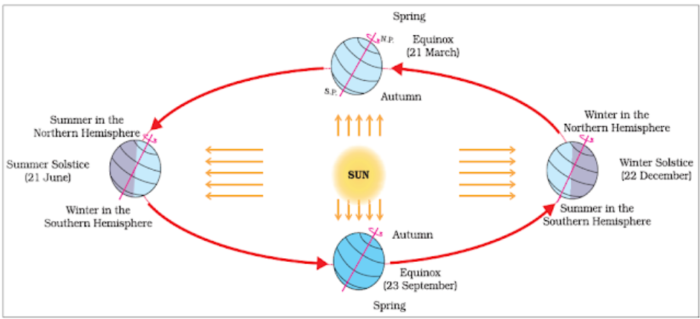Many believe that is is due to the act that the Earth orbiting around the Sun is not circular and equidistant, but in fact is an off-centere...
Many believe that is is due to the act that the Earth orbiting around the Sun is not circular and equidistant, but in fact is an off-centered an elliptical. However, the real reasons behind the seasons have nothing to do with how far the Earth is located from the Sun at any given point in time. If this were the case, it would be hotter in the northern hemisphere during January (as the Earth is closer to the Sun at this time) as opposed to July.
Instead, the seasons as we know and experience it are caused due to the Earth's axial tilt (on its rotational axis) by an approximate of 23.5 degrees, with respect to the plane of orbit around the Sun. Earth's tilt on its axis actually varies from 22.1° to 24.5° over a period of approximately 40,000 years, which makes the difference so minute between years that it is not taken into consideration most of the time until it shifts by a tenth of a degree.
Coming to Earth's axial tilt and it effect on the season, here's the diagram explaining how it occurs:
When the Earth is at its closest point distance wise to the Sun in January and is called the Perihelion. Oppositely, it is furthest from the Sun in July and termed as the Aphelion. But this distance change is not great enough to cause any substantial difference in our climate. However, it is the Earth's axial tilt of 23.5° tilt which is all important for the changing of our seasons.
Somewhere close to June 21st (again it varies on date & time slightly every year), we call it Summer Solstice. It is at this time the Earth's tilt enables the northern most possible point/area to be directly positioned (perpendicular) to receive maximum Sunlight time thereby making it hotter and thus the peak of Summer. An imaginary circular line parallel to the Equator is draw at this location and is called the Tropic of Cancer, which is at 23.5 degrees north latitude to Equator.
It is exactly the opposite in the southern hemisphere, where the low sun angle produces the shortest day(s). Since the exposure of the Sun's energy is at it's minimum at this point/area as it is tilted away from the sun. Thus while its Summer in Northern Hemisphere, the Southern Hemisphere enters into peak Winter season because of the "leaning" away from the Sun creating shorter days.
This peak of Summer & Winter seasons on either hemispheres is termed as Solstices, the phenomenon occurs gradually over a period of 90 days on either sides (before & after). On this dates of 90 days either side encounters a perfect 50:50 day/night length, as the Sunlight is now perpendicular at Equator and is termed as Equinox(es) and it occurs twice every year, while opposite condition of Summer & Winter occurs once every year.
The Earth is said to be in Autumnal Equinox around September 21st, and around March 21st, it is said to be in Spring Equinox, as the Sun is once again directly over the equator.
Winter Solstice is around 21st of December, when the Sun is positioned directly over the southern most possible point/area, and another imaginary circular line again parallel to the Equator is called as 'Tropic of Capricorn', which is in 23.5° Southern latitude. At this point in time, the southern hemisphere receives the direct sunlight making it Summer there, while the Northern half experiences winter as it is tilted away from the Sunlight for the maximum amount of time in an entire day producing shorter days.
Why we consider Summer during June Solstice? and not during Southern favour, you might ask!
What kind of effect does the earth's tilt has on the sunrise to sunset i.e., length of daylight?
For the regions in between the Tropic of Cancer & Capricorn, the effect varies for a few minutes to a couple of hours of shift, however, beyond the Tropics the day/night length gets exaggerated to many hours towards to zero changes every half cycle of an year (near the poles).
The region of Artic & Antarctic has another set of imaging circular lines at 66.5°, again in respect to the Equator, which experiences total day and total night during Summer & Winter Equinoxes. It is because the angle of incidence of sunlight creates no shadow or complete shadow from the resultant tilt during the annual cycle of Earth around the Sun. This is the very fact of the extremely frozen temperatures during major length of the year at these regions.
Now, why do we need to learn about all these?
Well, we need Energy for everything and seasons make it happen. If you take careful notice that every form of energy we experience is either direct or indirectly sourced from Sun's incident energy on our planet. Every type of life form depend on it, including us humans. Be if for food, electricity or any other form energy we use in our daily life comes from the Sun. So we call it the Solar system as our home, and this is why we find in every human belief systems, the Sun as the focal point of worship and importance.


No comments